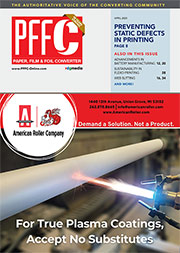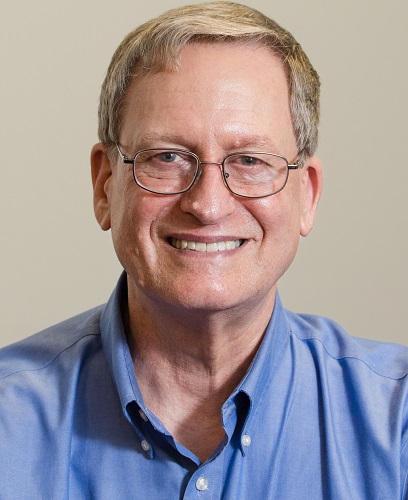Featured Stories
-
Advantages of Shear, Razor and Crush Web Slitting Techniques
When choosing a slitting method, many factors must be considered, including interaction with inspection systems. -
Revolutionizing Lithium-lon Battery Manufacturing Advances in Slot-Die and Electrode Coating Technology
As the global battery market surges toward an estimated $328 billion by 2028, innovations in manufacturing processes are becoming increasingly... -
Nordson Divisions Collaborate to Achieve Unprecedented Flat Profile Time
Nordson Measurement & Control Solutions (a division of Nordson Corporation) is a global leading provider of gauging systems for the film...
News | New Products
-
Morris Packaging to Add New KY Flex-pack Plant
Bloomington, IL-based Morris Packaging plans to build a new $60.9-million production plant in Marion County (KY), a project that will create 276 full-time jobs.
-
Press Belt Manufacturer IPCO to Focus on Engineering and Service Expertise
IPCO will use Ligna 2025 to highlight the service and support services it provides to press manufacturers and WBP producers alike.
-
INX promotes seven Executives to Vice President positions
INX International Ink Co. has announced the Board of Directors has approved the promotions of seven key people to Vice President positions.
-
Bimec and Flex CA Strengthen U.S. Market Presence with a new installation at Cello-Wrap Packaging Inc.
Bimec and Flex CA proudly announce a new milestone in their U.S. market expansion with the recent commissioning of a state-of-the-art slitter rewinder at Cello-Wrap Packaging Inc, located in Farmersville - TX.
-
New Era Converting promotes industry veteran Stephen Pickett to controls engineering manager
New Era Converting, an IPCO company, has announced that Stephen Pickett is taking on a new role as controls engineering manager.
-
Fedrigoni Announces New Slitting Center for Self-Adhesive Labels in Germany in Q4 2025
The Fedrigoni Group - a world reference in the manufacturing of self-adhesive labels, special papers for packaging and other creative applications, graphic supports for visual communication and RFID
-
Advancing Label Innovation Through Collaboration
Packaging is a physical representation of a brand’s identity, and label converters play an essential role in bringing the packaging experience to life.
Expert Advice
Flexo/screen proves to be a winning combination
- Published: February 01, 1996, By Simonsis, Yolanda
A Mark Andy flexo press helps Topflight combine the advantages of rotary screen and flexo without requiring a heavy dollar investment.
The motto on the wall of Topflight Corp.'s York, PA, headquarters contains a simple declaration: "At Topflight, quality is a way of life."
The company's emphasis on quality is evident in its equipment, technologies, people, and, ultimately, end products. Topflight relies on that combination to meet the needs of a diverse client base. Customers ranging from Motorola and Black & Decker to Maybelline Cosmetics and the US Customs Service all, in turn, rely on Topflight for their high quality, color process labels.
The company last year further enhanced its capabilities by adding a transportable "RS" rotary screen printing station, built by Stork X-Cel, to the top of its 16-in., six-color Mark Andy 4120 press. (The unit can complement any 4000 Series Mark Andy with press widths of 10, 16, and 20 in.) The versatile unit is located above the press's six stationary print units on a unique Quick Positioning System (QPS) rail transport system that was installed by a team of Stork/Mark Andy engineers. Consequently, it can be positioned over any of the print stations. An RS rotary screen unit can also be located on a fixed platform at any designated position within the press.
"I think the combination press, especially a flexo/screen combination, is a definite must for success in the future," says Charles Brown, VP of manufacturing at Topflight. "The capital outlay is considerably less than other combination presses, and there is no compromise in quality."
The RS has a repeat of 12 to 24 in. and can achieve speeds to 450 fpm. No squeegee sharpening is required, and controls on the front of each printhead make for easy access. The screen is in a constant turning mode while in a stop or job mode to prevent ink loss through the screen, and it returns to register automatically upon press startup.
The Stork Rotamesh screens are 100% nickel, eliminating rips and tears said to be common to polymer-based screens. The screens are also reusable on new jobs up to 15 times.
For a company its size, Topflight finds the Mark Andy/Stork screen printing system an ideal complement to existing equipment and technologies, which also include letterpress and gravure. ("If an important new converting system is out there, we've probably got one," Brown says with a smile.)
For companies with more limited resources but with the same demand for quality, the Mark Andy/Stork screen head can be a versatile and much-needed addition to their equipment mix, says Brown. "I think it's a great opportunity for a small label company that doesn't want or can't afford to spend $1.5 million on a letterpress/screen combination press. Here, you can get six or seven colors and a couple of screen heads, and you spend considerably less than $500,000 for this package - and you're not going to get an inferior product. In fact, this is probably as good as any combination press out there."
And that's something this company could likely afford to do. Topflight operates two facilities in the US and seven overseas. At its York plant, the converter has a diverse range of equipment capable of printing up to eight colors at a maximum web width of 16 in.
In addition to the Mark Andy 4120 with the optional screen head, Topflight also operates a four-color, 7-in. Mark Andy 2200 with ion deposition capabilities for applications that require the printing of variable information. Presses utilizing other printing processes offer enhanced capabilities, "and Mark Andy is certainly an integral part of that mix," Brown notes.
New Press Purchase Planned
Topflight is interested in one of Mark Andy's newest presses, the "FP" Series flexible packaging narrow web press for printing on light films. The press, which was introduced in August at CMM International, is designed for short runs and can produce a combination of high quality flexo, ultraviolet flexo, and screen-printed graphics.
The in-line chill drum press can produce short-run labels more cost-effectively than wide, central-impression presses. Even films as thin as 1 mil can be controlled through multiple printing and converting-with tight register and minimal waste-by using light-tension features and chilled drums built into the Mark Andy "FP" Series, according to Brown.
"Until Mark Andy came along, the only real piece of equipment we had for running 1.5-mil unsupported polyvinyl chloride [PVC] film was our central-impression flexo presses that range in size to 13 inches," says Brown. "We're anxious to look at this new Mark Andy system for converting thinner materials in a narrower format. It should prove a valuable complement to our CI presses."
Brown, a board member of the Tag and Label Mfrs. Institute, notes that one of that group's current issues of study is the growing number and changing nature of materials being used to convert finished labels. End users are demanding materials that will offer the same superior performance but at a lower cost than several years ago.
"You buy raw materials by the pound, so it makes sense that using thinner materials will save you money," explains Brown, "but you still must maintain the same level of quality." The question is how to successfully run that thinner material through the press without it shrinking or wrinkling while simultaneously staying in register. "A 1.5-mil film is one thing," explains Brown, "0.5 mil is something very different."
Speedy Delivery, Superior Service
Topflight relies on improving technology not only to better serve the customer but to outperform the competition. Brown notes that there are more than 2,000 pressure-sensitive label converters in the country. While few have the range of capabilities offered by Topflight, many are capable of delivering a quality product to their niche markets with reputations comparable to that of Topflight.
To successfully set itself apart from the competition, Topflight offers superior service and turnaround. "We don't want the customer to wait for anything," Brown notes. The company has been working for more than two years to reduce its lead time on every job-from simple one-color jobs to four-color process jobs.
"We know we're good enough on the mechanical side," says Brown. "Our quality is high and our waste is very low. The next step is to get product to our customers even sooner."
To help accomplish that, Topflight has developed a proprietary order tracking and scheduling system that allows every department, from sales and service to marketing and manufacturing, to instantly access the status of any order in process. Under the system, each department now serves as the "supplier" and "customer" of another. The art department serves platemaking, which serves mounting, ink matching, etc.
In addition, the company formed a special planning group composed of elite members from each department to coordinate and oversee their combined efforts. "It is their job to make sure that whatever the sales and service department wants, it gets," Brown reports. "It is their job to anticipate and avoid potential problems on the production floor."
The new computer scheduling system helps pull the various departments together, providing real-time information to each one at the touch of a button. If someone in any department needs to make a change, the program will instantly show how that change will affect not only the operations of the other departments but delivery times as well.
"Our intent is to track every order while it's here at Topflight," says Brown. "If it's in the art department, we want to know which artist is working on it and when it's coming out - not just what day, but what time it's going to come out of the art department. That's what we need to know, and that's what the system has been designed to tell us."
R&D Investment Ensures Future
Such innovations, says Brown, help Topflight stand apart from the competition. Because it is so large, the company has the time and expertise to "dabble" in the latest emerging technologies. That allows Topflight to spend literally years on research and development, if necessary, getting a head start on perfecting a new technology - usually well before it becomes a commodity on the marketplace.
"Because we're so varied in the equipment and the talent that we have, some of the things that we're willing and able to spend time on make a difference," according to Brown. "We actually work on some projects two, three, or four years before they take shape. But after we do develop something, we're so technically prepared and knowledgeable about the job that it results in a great deal of business for us that encompasses research, the final product, and marketing."
The long history between Topflight and Mark Andy - and their parallel dedication to utilizing and developing state-of-the-art technologies - isn't lost on Brown, himself a long-time industry veteran. He perhaps echoes a similar Mark Andy attitude: "You can make labels, and you can make printing presses, but it's the people behind the label and the printing press that are important to us."













